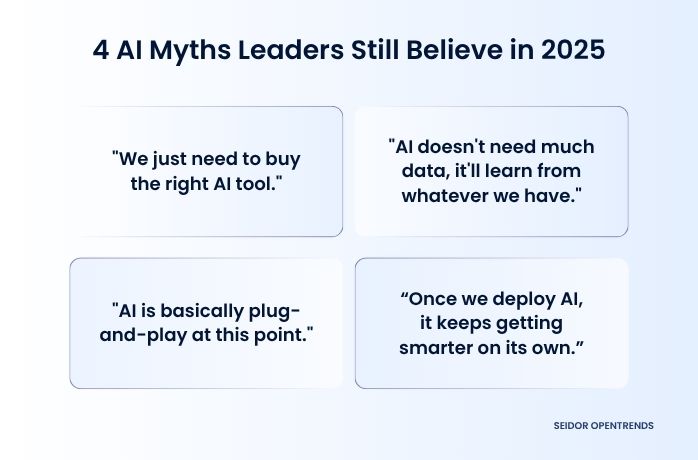
The Scariest AI Myths Haunting Boardrooms in 2025
AI isn’t scary. The myths around it are. We asked leaders across finance, manufacturing, semiconductor, retail, and pharma what they still believe about AI or have heard in their board meetings. Every time the topic of AI comes up, certain phrases echo like ghost stories. Everyone nods, CFOs approve the spend, and months later, the project flatlines.
Here's the uncomfortable truth: most AI failures don't happen because the technology doesn't work. They happen because leaders are operating on outdated assumptions that sound right but play out wrong. Myths that create false confidence, waste millions, and quietly derail strategy.
In the spirit of Halloween, let’s talk about the four most-mentioned scary AI myths and why they’re dangerous.
Myth #1: “We just need to buy the right AI tool”
This is the equivalent of thinking a gym membership will get you in shape.
AI isn't a product you purchase. It's a muscle you build. Without the surrounding infrastructure (strategy, clean data, governance, organizational readiness) that expensive new tool becomes very expensive shelfware.
We watched a retail company drop serious money on an AI customer segmentation platform. They expected immediate campaign optimization. Fast forward six months: engagement numbers barely moved. The platform worked fine. But nobody had thought through the data integration. Or the workflow changes. Or how to actually use the insights.
The tool was installed. The capability wasn't there.
👉 What actually works: treating AI as a strategic initiative, not a procurement decision. You need the infrastructure, the process changes, and the organizational buy-in before the technology delivers value.
Myth #2: “AI doesn't need much data, it'll learn from whatever we have.”
This one makes our eye twitch because it's so backwards. AI models are pattern-recognition machines. Feed them incomplete patterns, and they'll confidently give you incomplete answers. Garbage in, garbage out isn't just a saying.
We've seen life sciences teams try to deploy AI for regulatory compliance using datasets that were fragmented across legacy systems. Different naming conventions. Missing fields. Inconsistent formats. The modeling team spent weeks trying to make it work, but you can't extract signal from noise.
The scary part? They'd already committed to timelines based on the assumption that AI would "figure it out."
👉 What actually works: unglamorous data work. Cleaning, standardizing, governing. Ensuring your data is AI-ready before you train models on it. It's not sexy, but it's the difference between systems that work and expensive science projects.
Get Insider Knowledge Delivered
Receive exclusive insights and tech industry updates directly from our team of experts. Our quarterly newsletter provides concise and actionable information tailored for busy leaders like you.
Myth #3: “AI is basically plug-and-play at this point.”
If only. This myth treats AI like installing software: click install, restart your computer, done. But AI touches everything: systems, workflows, people, culture. Integration isn't a technical checkbox. It's an organizational change.
A financial services firm deployed an AI risk assessment engine. Technically sound. Impressive accuracy on paper. But the risk officers didn't trust it. IT hadn't integrated it with their core platforms. Training was minimal. Six months in, adoption was below 20%. Eventually, they shelved it.
The technology worked. The organization wasn't ready.
👉 What actually works: treating deployment as a change management exercise as much as a technical one. That means stakeholder engagement, workflow redesign, training programs, and feedback loops. AI succeeds when people actually use it, and that requires intentional adoption work.
Myth #4: “Once we deploy AI, it keeps getting smarter on its own.”
This is the most dangerous myth because it sounds sophisticated. The logic goes: AI is machine learning (ML), ML means continuous improvement, therefore AI gets smarter over time. Except that's not how it works in production environments.
Models drift. Markets evolve. Edge cases emerge. Without active monitoring and retraining, AI performance degrades. Sometimes slowly, other fast.
👉 What actually works: treating AI like a living system that requires care and feeding. Continuous monitoring. Regular retraining. Human oversight to catch drift and bias. The most successful AI deployments we've seen have humans in the loop, keeping models honest and aligned with business reality.

Why This Matters Now
These myths don't just slow you down. They create false leadership confidence while burning real dollars.
Research shows 4 in 10 AI initiatives fail, mostly due to poor data quality, weak integration, or unclear strategy. It's mostly an execution problem driven by faulty assumptions.
Think about what that means in opportunity cost. Product launches delayed by quarters. Revenue targets missed. Operational efficiencies that never materialize. Your competitors aren't waiting for you to figure this out.
What Companies Getting It Right Actually Do
In our experience, organizations that are seeing real AI impact today share a few key characteristics. They didn't assume AI would solve problems automatically. Instead, they:
- Built capability systematically
They treated AI as infrastructure. That meant investing in data foundations, integration architecture, and organizational readiness before getting seduced by algorithms.
- Took data seriously
Not as a nice-to-have, but as the raw material that determines everything else. They invested in governance, quality, and accessibility, the boring work that makes the exciting work possible.
- Designed for adoption
They understood that technology only creates value when people actually use it. That meant stakeholder engagement from day one, training programs that stick, and feedback mechanisms to iterate based on real-world usage.
- Kept humans in the loop
They didn't treat AI as a replacement for judgment but as an augmentation of it. Continuous oversight, regular recalibration, ethical guardrails; all the things that keep AI aligned with business outcomes and real-world complexity.
At SEIDOR Opentrends, we've been deep enough in implementation trenches to know where these myths come from. They're comforting. They make AI sound manageable, predictable, easy. The reality is more demanding.
We've also seen what happens when companies move past the myths and do the actual work. Fraud detection systems that save millions. Supply chain optimizations that turn logistics into competitive advantage. Customer intelligence that drives double-digit growth. Not because they bought better tools. Because they built better capabilities.
Where Do You Go From Here?
AI doesn't fail. Assumptions do. Your competitors aren't waiting for perfect conditions or silver bullets. They're building capabilities now, learning fast, and compounding advantages quarter over quarter.
Ready to move past the myths?
FAQs About AI Myths and Why AI Projects Fail
Why do most AI projects fail in enterprises?
Most AI project failures aren’t caused by weak technology, but by poor execution. Common reasons include weak data quality, lack of governance, and the false belief that AI is “plug-and-play.” Without the right enterprise AI strategy (covering infrastructure, clean data, and organizational readiness), companies risk spending millions on tools that hardly ever deliver full value.
How does data quality impact AI implementation success?
Data quality is one of the biggest drivers of AI success or failure. AI systems are only as strong as the data they are trained on, if the data is fragmented, inconsistent, or poorly governed, outputs will be incomplete or inaccurate. Companies that prioritize data cleaning, standardization, and governance before deploying AI significantly reduce failure rates. In fact, strong data foundations are often the difference between AI adoption challenges and measurable business outcomes.
What role does change management play in AI adoption?
AI adoption challenges are rarely technical; they are organizational. Even the best AI models fail when employees don’t trust or use them. Change management ensures smooth integration by aligning workflows, training users, and engaging stakeholders. Without it, adoption stalls, and projects are abandoned. Treating AI deployment as both a technology and change management exercise ensures higher adoption, better ROI, and sustainable business transformation.
How does SEIDOR Opentrends help enterprises overcome AI myths and failures?
SEIDOR Opentrends' approach focuses on building AI strategy systematically: investing in data quality, integration, governance, and adoption programs. We keep humans in the loop, ensuring continuous monitoring, retraining, and ethical oversight. This proven methodology has delivered results for finance, manufacturing, higher education institutions and public sectors, showing that the right AI strategy turns risk into competitive advantage.





